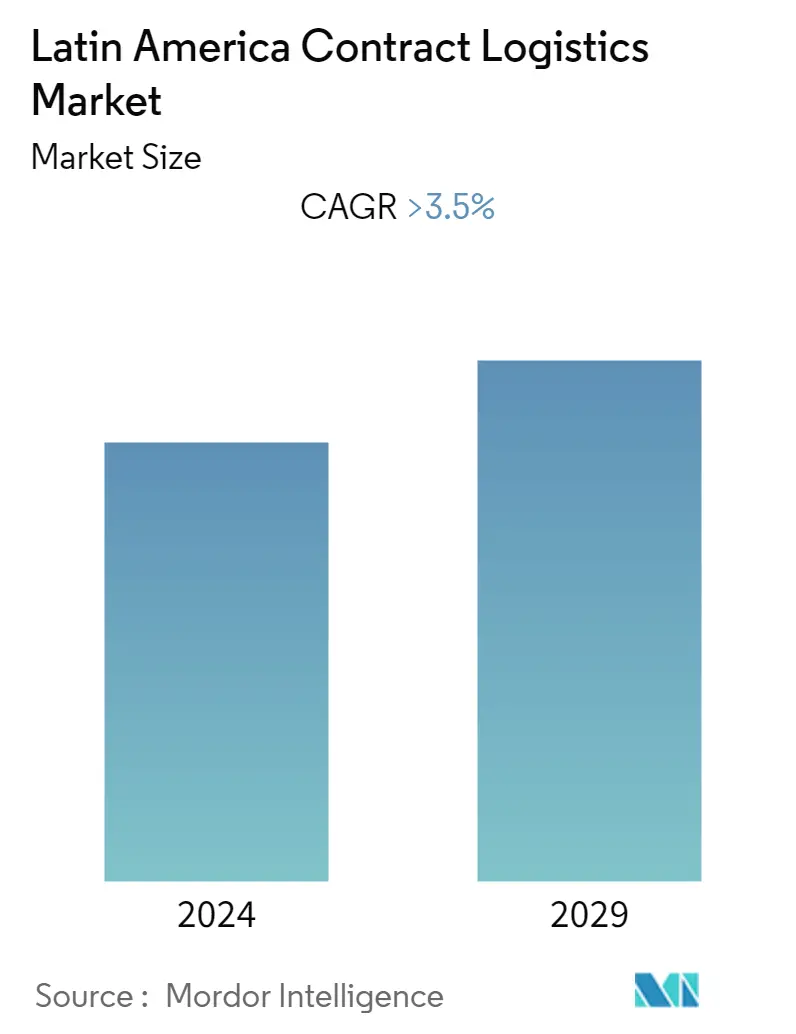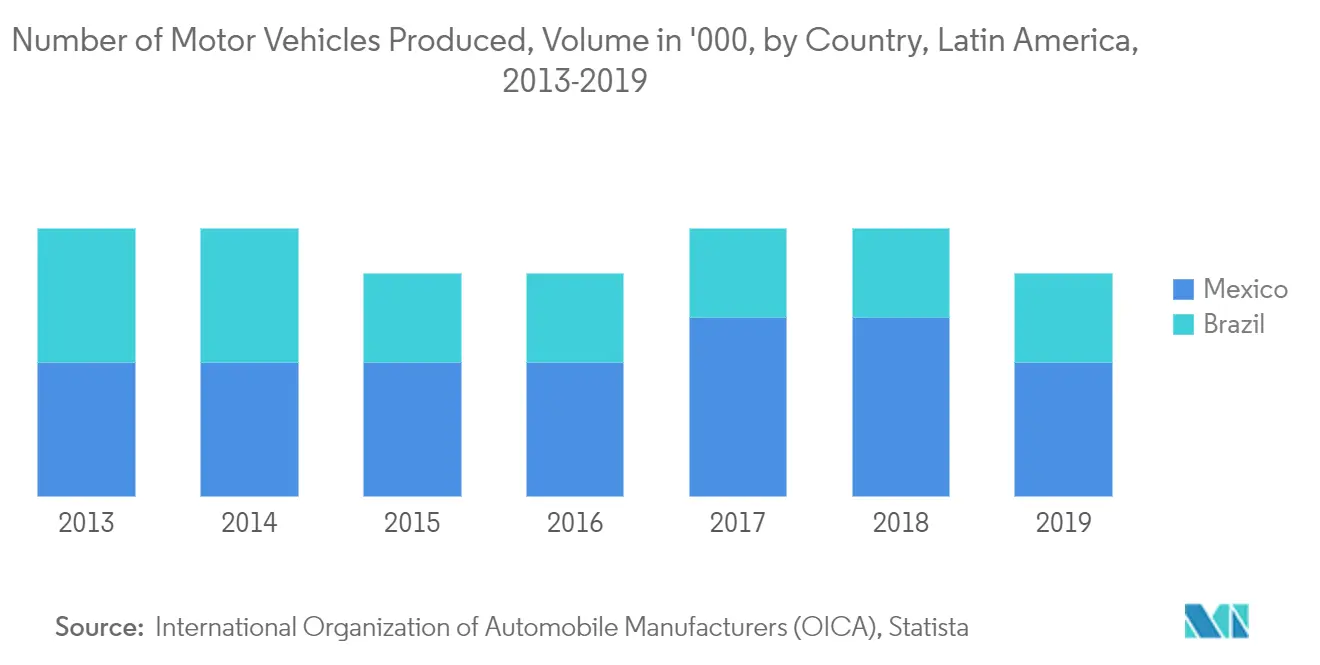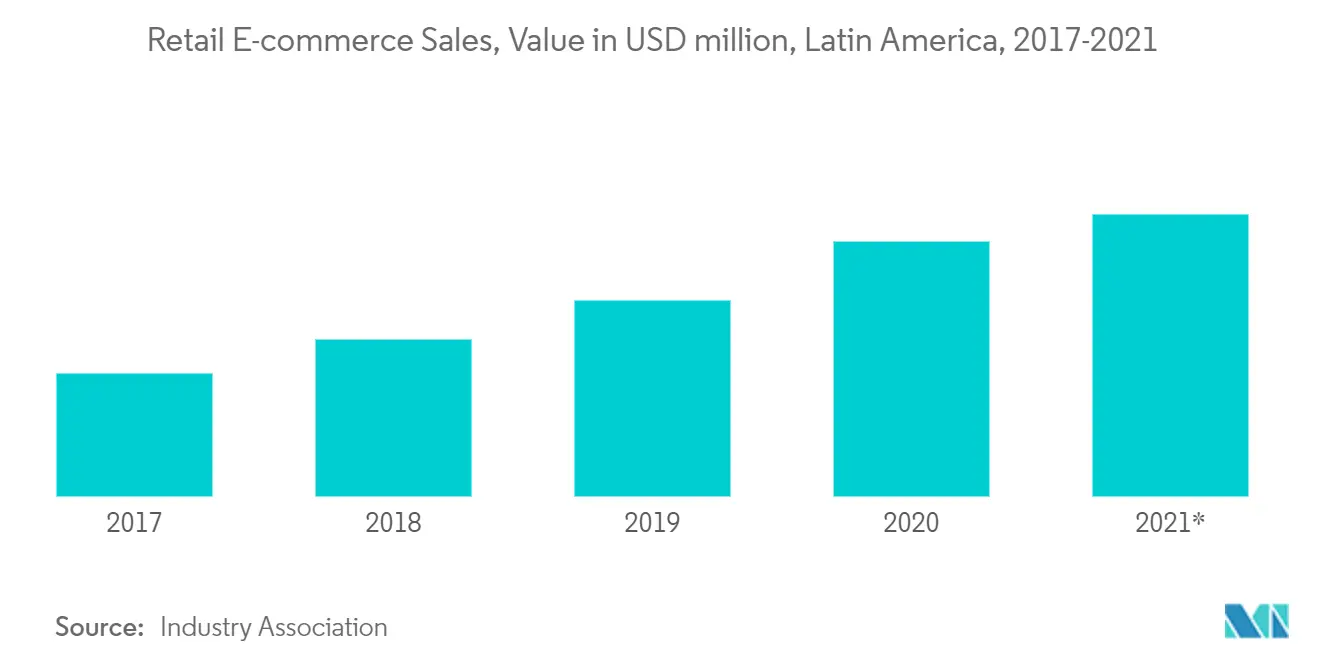Latin America Contact Logistics Market Size

| Study Period | 2020 - 2029 |
| Base Year For Estimation | 2023 |
| Forecast Data Period | 2024 - 2029 |
| Historical Data Period | 2020 - 2022 |
| CAGR | 3.50 % |
| Market Concentration | High |
Major Players
*Disclaimer: Major Players sorted in no particular order |
Latin America Contact Logistics Market Analysis
The Latin American contract logistics market is expected to exhibit a growth rate of more than 3.5% during the forecast period. During the COVID-19 pandemic, due to lockdowns, there has been an increase in demand for online shopping in several areas in Latin America, which requires the manufacturing, food and beverage, and logistics sectors to streamline their supply chains, providing the consumers with an increase in speed and accuracy of order processing and delivery.
The rapid growth of international trade of perishable goods, technological progress in transportation and storage facilities, and infrastructure development support by the government are the major driving factors for the growth of the Latin American contract logistics market. The increased implementation of tech-driven logistics services and IoT-enabled connected devices are accelerating the growth of the market. However, lack of infrastructure and high cost of logistics services hinder the market growth.
Latin America Contact Logistics Market Trends
This section covers the major market trends shaping the Latin America Contact Logistics Market according to our research experts:
Growth in the Automotive Sector is Spearheading the Market
Countries like Brazil, Colombia, and Argentina have been facing political and economic crises leading to a downturn in the growth of the automotive sector. However, Mexico, despite sluggish economic growth, has been laying a solid ground for growth in the automotive sector. The country's competitive manufacturing costs, compact supply chain, and transport links to the United States have made it a huge recipient of automotive investment, especially as an export hub to the United States and Canada.
The region has Mexico and Brazil with the most developed automotive sectors - Mexico produced about 4 million motor vehicles in 2019, while the production in Brazil added up to almost 3 million units that year. In fact, these two Latin American countries ranked amongst the largest motor vehicle producers worldwide, with Ford, Volkswagen, and Toyota among the leading players in Latin America.
Such growth in the sector is strongly demanding the involvement of the contract logistics players to support the transportation and storage of the vehicles and parts to the domestics as well as international markets.

Focus on Last-mile Cost Reduction
The growing e-commerce market in the Latin American region is leading the logistics players in the region to focus on warehousing, inventory management, and modes to provide faster deliveries incurring the least cost. The sector demands the logistics players to position their warehousing closer to city centers to facilitate same-day delivery services.
Implementation of big data management in the sector lowers costs, speeds fulfillment, and improves accuracy. E-commerce in Latin America also creates opportunities for legacy logistics providers.
In Latin America, logistics companies face huge traffic issues and spend a great deal of time finding and identifying un-named streets. Companies like Rappi, Chazki, and CargoX are developing in the market with their network of drivers and vehicles to deliver items leading towards a market to drop their pricing.

Latin America Contact Logistics Industry Overview
The Latin American contact logistics market is fairly fragmented, with various domestic and international players, including AP Moller, DB Schenker, and DHL Supply Chain. Even though these major players have a strong footprint across the region and account for significant market share, the market is still fragmented to some extent, with many players providing contract logistics services at different levels. The companies in the sector are following the trend of acquisitions in order to grow and be competitive in the market.
Latin America Contact Logistics Market Leaders
-
DB Schenker
-
DHL Supply Chain
-
CH Robinson
-
FedEx
-
GEODIS
*Disclaimer: Major Players sorted in no particular order

Latin America Contact Logistics Market News
July 2020: CEVA Logistics Mexico was appointed to operate a new dedicated warehouse to support IKEA Mexico's operations in the country. This facility opening is an extension of the existing successful global partnership between CEVA and the world's largest furniture retailer.
June 2020: CEVA Logistics won an extension to its contract with Volkswagen for the operation of the company's auto spares center at Vinhedo in Brazil.
Latin America Contact Logistics Market Report - Table of Contents
1. INTRODUCTION
- 1.1 Study Assumptions
- 1.2 Scope of the Study
2. RESEARCH METHODOLOGY
- 2.1 Analysis Methodology
- 2.2 Research Phases
3. EXECUTIVE SUMMARY
4. MARKET DYNAMICS AND INSIGHTS
- 4.1 Current Market Scenario
-
4.2 Market Dynamics
- 4.2.1 Drivers
- 4.2.2 Restraints
- 4.2.3 Opportunities
- 4.3 Industry Attractiveness - Porter's Five Forces Analysis
- 4.4 Value Chain/Supply Chain Analysis
- 4.5 Government Regulations and Initiatives
- 4.6 Technological Trends
- 4.7 Insights into the E-commerce Industry in the Region (Both Domestic and Cross-border)
- 4.8 Insights into Contract Logistics in the Context of After-sales/Reverse Logistics
- 4.9 Spotlight - Freight Transportation Costs/Freight Rates
- 4.10 Impact of COVID-19 on the Market
5. MARKET SEGMENTATION
-
5.1 By Type
- 5.1.1 Insourced
- 5.1.2 Outsourced
-
5.2 By End User
- 5.2.1 Industrial Machinery and Automotive
- 5.2.2 Food and Beverage
- 5.2.3 Chemicals
- 5.2.4 Other End Users
-
5.3 By Geography
- 5.3.1 Mexico
- 5.3.2 Brazil
- 5.3.3 Colombia
- 5.3.4 Chile
- 5.3.5 Rest of Latin America
6. COMPETITIVE LANDSCAPE
- 6.1 Market Concentration Overview
-
6.2 Company Profiles
- 6.2.1 DB Schenker
- 6.2.2 DHL Supply Chain
- 6.2.3 C.H. Robinson Worldwide Inc.
- 6.2.4 FedEx
- 6.2.5 GEODIS
- 6.2.6 United Parchel Services (UPS)
- 6.2.7 Kuehne + Nagel International AG
- 6.2.8 DSV
- 6.2.9 CEVA Logistics
- 6.2.10 Penske Logistics*
- *List Not Exhaustive
- 6.3 Other Companies*
7. FUTURE OF THE MARKET
8. APPENDIX
- 8.1 GVA by Activity for Key Countries
- 8.2 Insights into Capital Flows
- 8.3 External Trade Statistics - Export and Import by Product
- 8.4 Insights into Key Export Destinations
- 8.5 Insights into Key Import Origins
Latin America Contact Logistics Industry Segmentation
Contract logistics refers to the outsourcing of resource management tasks to a third-party company. Contract logistics companies handle activities such as designing and planning supply chains, designing facilities, warehousing, transporting and distributing goods, processing orders and collecting payments, managing inventory, and even providing certain aspects of customer service.
The report provides a complete background analysis of the Latin American contract logistics market, which includes an assessment of the economy, emerging trends by segments and regional markets, significant changes in market dynamics, market overview, and company profiles. The report also covers the impact of COVID - 19 on the market.
The Latin American contract logistics market is segmented by type (outsourced and insourced), end user (manufacturing and automotive, consumer goods and retail, hi-tech, healthcare and pharmaceuticals, and other end users), and country (Mexico, Brazil, Colombia, Chile, and Rest of Latin America).
| By Type | Insourced |
| Outsourced | |
| By End User | Industrial Machinery and Automotive |
| Food and Beverage | |
| Chemicals | |
| Other End Users | |
| By Geography | Mexico |
| Brazil | |
| Colombia | |
| Chile | |
| Rest of Latin America |
Latin America Contact Logistics Market Research FAQs
What is the current Latin America Contract Logistics Market size?
The Latin America Contract Logistics Market is projected to register a CAGR of greater than 3.5% during the forecast period (2024-2029)
Who are the key players in Latin America Contract Logistics Market?
DB Schenker, DHL Supply Chain, CH Robinson, FedEx and GEODIS are the major companies operating in the Latin America Contract Logistics Market.
What years does this Latin America Contract Logistics Market cover?
The report covers the Latin America Contract Logistics Market historical market size for years: 2020, 2021, 2022 and 2023. The report also forecasts the Latin America Contract Logistics Market size for years: 2024, 2025, 2026, 2027, 2028 and 2029.
Latin America Contact Logistics Industry Report
Statistics for the 2024 Latin America Contact Logistics market share, size and revenue growth rate, created by Mordor Intelligence™ Industry Reports. Latin America Contact Logistics analysis includes a market forecast outlook 2029 and historical overview. Get a sample of this industry analysis as a free report PDF download.



